Thallium(I) Tropolonates: Synthesis, Structure, Spectral Characteristics, and Antimicrobial Activity Compared to Lead(II) and Bismuth(III) Analogues
Abstract
:1. Introduction
2. Results and Discussion
2.1. Synthesis
2.2. Crystal Structures
2.2.1. Crystal Structures of Thallium(I) Triflate and Its Adduct with Tropolone
2.2.2. Complexes with Tropolone and 5-Methyltropolone: Tl(trop) (1) and Tl(5-metrop) (2)
2.2.3. Complexes with Hinokitiol: Tl(hino) (3) and {Tl@[Tl(hino)]6}(OTf) (4)
2.3. Spectroscopic Analysis
2.4. Antimicrobial Activity
3. Materials and Methods
3.1. Preparation of the Thallium(I) Compounds
3.1.1. Tl(CF3SO3) (Tl(OTf))
3.1.2. Co-Crystals of Thallium(I) Triflate and Tropolone-Tl(OTf)·Htrop
3.1.3. Tl(trop) (1)
3.1.4. Tl(5-metrop) (2)
3.1.5. Tl(hino) (3)
3.1.6. Tl@[Tl(hino)]6}(OTf) (4)
3.2. Single-Crystal X-ray Diffraction
3.3. Antimicrobial Activity
4. Conclusions
Supplementary Materials
Author Contributions
Funding
Institutional Review Board Statement
Informed Consent Statement
Data Availability Statement
Acknowledgments
Conflicts of Interest
Sample Availability
References
- Ouyang, W.-C.; Liao, Y.-W.; Chen, P.-N.; Lu, K.-H.; Yu, C.-C.; Hsieh, P.-L. Hinokitiol suppresses cancer stemness and oncogenicity in glioma stem cells by Nrf2 regulation. Cancer Chemother. Pharmacol. 2017, 80, 411–419. [Google Scholar] [CrossRef]
- Saniewski, M.; Horbowicz, M.; Kanlayanarat, S. The biological activities of troponoids and their use in agriculture. J. Hort. Res. 2014, 22, 5–19. [Google Scholar] [CrossRef] [Green Version]
- Shih, Y.-H.; Chang, K.-W.; Hsia, S.-M.; Yu, C.-C.; Fuh, L.-J.; Chi, T.-Y.; Shieh, T.-M. In vitro antimicrobial and anticancer potential of hinokitiol against oral pathogens and oral cancer cell lines. Microbiol. Res. 2013, 168, 254–262. [Google Scholar] [CrossRef]
- Morita, Y.; Matsumura, E.; Okabe, T.; Shibata, M.; Sugiura, M.; Ohe, T.; Tsujibo, H.; Ishida, N.; Inamori, Y. Biological activity of tropolone. Biol. Pharm. Bull. 2003, 26, 1487–1490. [Google Scholar] [CrossRef] [Green Version]
- Koufaki, M.; Theodorou, E.; Alexi, X.; Nikoloudaki, F.; Alexis, M.N. Synthesis of tropolone derivatives and evaluation of their in vitro neuroprotective activity. Eur. J. Med. Chem. 2010, 45, 1107–1112. [Google Scholar] [CrossRef]
- Baya, M.; Soulounganga, P.; Gelhaye, E.; Gérardin, P. Fungicidal activity of β-thujaplicin analogues. Pest. Manag. Sci. 2001, 57, 833–838. [Google Scholar] [CrossRef]
- Nomiya, K.; Onodera, K.; Tsukagoshi, K.; Shimada, K.; Yoshizawa, A.; Itoyanagi, T.; Sugie, A.; Tsuruta, S.; Sato, R.; Kasuga, N.C. Syntheses, structures and antimicrobial activities of various metal complexes of hinokitiol. Inorg. Chim. Acta 2009, 362, 43–55. [Google Scholar] [CrossRef]
- Barret, M.C.; Mahon, M.F.; Molloy, K.C.; Steed, J.W.; Wright, P. Synthesis and Structural Characterization of Tin(II) and Zinc(II) Derivatives of Cyclic α-Hydroxyketones, Including the Structures of Sn(maltol)2, Sn(tropolone)2, Zn(tropolone)2, and Zn(hinokitiol)2. Inorg. Chem. 2001, 40, 4384–4388. [Google Scholar] [CrossRef]
- Gilbard, J.P.; Douyon, Y.; Huson, R.B. Time-kill assay results for a linalool-hinokitiol-based eyelid cleanser for lid hygiene. Cornea 2010, 29, 559–563. [Google Scholar] [CrossRef]
- Nagao, Y.; Sata, M. Effect of oral care gel on the quality of life for oral lichen planus in patients with chronic HCV infection. Virol. J. 2011, 8, 348. [Google Scholar] [CrossRef] [PubMed] [Green Version]
- Muetterties, E.L.; Wright, C.M. Chelate Chemistry. I. Tropolone and Aminotroponimine Derivatives of the Main-Group Elements. J. Am. Chem. Soc. 1964, 86, 5132–5137. [Google Scholar] [CrossRef]
- Muetterties, E.L.; Roesky, H.; Wright, C.M. Chelate Chemistry. V. Metal Chelates Based on Tropolone and Its Derivatives. J. Am. Chem. Soc. 1966, 88, 4856–4861. [Google Scholar] [CrossRef]
- Diemer, R.; Keppler, B.K.; Dittes, U.; Nuber, B.; Seifried, V.; Opferkuch, W. Preparation and Characterization of Biologically Active Bismuth(III) Tropolonato Complexes. Chem. Ber. 1995, 128, 335–342. [Google Scholar] [CrossRef]
- Lyczko, K.; Starosta, W.; Persson, I. Influence of pH and Counteranion on the Structure of Tropolonato−Lead(II) Complexes: Structural and Infrared Characterization of Formed Lead Compounds. Inorg. Chem. 2007, 46, 4402–4410. [Google Scholar] [CrossRef]
- Lyczko, K.; Lyczko, M.; Wozniak, K.; Stachowicz, M.; Oziminski, W.P.; Kubo, K. Influence of pH and type of counterion on the formation of bismuth(III) complexes with tropolonato and 5-methyltropolonato ligands: Synthesis, structure, spectroscopic characterization and calculation studies. Inorg. Chim. Acta 2015, 436, 57–68. [Google Scholar] [CrossRef]
- Lyczko, K. Tropolone as anionic and neutral ligand in lead(II) and bismuth(III) complexes: Synthesis, structure, characterization and computational studies. J. Mol. Struct. 2017, 1127, 549–556. [Google Scholar] [CrossRef]
- Lyczko, K.; Lyczko, M.; Starosta, W. Catena-Poly[(µ3-2-hydroxy-4-isopropylcyclohepta-2,4,6-trien-1-onato)(µ2-2-hydroxy- 4-isopropylcyclohepta-2,4,6-trien-1-onato)lead(II)]. Acta Crystallogr. E 2010, 66, 1395–1396. [Google Scholar] [CrossRef] [Green Version]
- Chow, Y.M.; Britton, D. The Crystal Structures of Dimethylthallium Acetate, Tropolonate, Acetylacetonate, and Dibenzoylmethide. Acta Cryst. B 1975, 31, 1929–1934. [Google Scholar] [CrossRef]
- Griffin, R.T.; Henrick, K.; Matthews, R.W. Crystal Structures of Diethyldithiocarbamatodiphenylthallium(III) and DiphenyltropolonatothaIium(III). J. Chem. Soc. Dalton Trans. 1980, 1550–1555. [Google Scholar] [CrossRef]
- Curtis, S.; Lottes, B.; Robertson, D.; Lindeman, S.V.; Gerasimchuk, N. Search for the shortest intermetallic Tl–Tl contacts: Synthesis and characterization of Thallium(I) coordination polymers with several mono- and bis-cyanoximes. Inorg. Chim. Acta 2020, 508, 119597. [Google Scholar] [CrossRef]
- Castillo, R.; Cisterna, J.; Brito, I.; Conejeros, S.; Llanos, J. Structure and Properties of (CH3NH3)3Tl2Cl9: A Thallium-Based Hybrid Perovskite-Like Compound. Inorg. Chem. 2020, 59, 9471–9475. [Google Scholar] [CrossRef]
- Kianimehr, A.; Akhbari, K.; White, J.; Phuruangrat, A. Sonochemical synthesis, crystal structure and thermal behavior of a new thallium(I) supramolecular polymer with hydrogen and bromine-oxygen halogen bonds. Inorg. Chem. Comm. 2020, 115, 107864. [Google Scholar] [CrossRef]
- Golovnev, N.N.; Molokeev, M.S.; Lesnikov, M.K. Three isomers in a (hydrogen L-Cysteinato)-thallium(I): Crystal structure, spectroscopic and thermal properties. Polyhedron 2019, 173, 114141. [Google Scholar] [CrossRef]
- Lavrentyev, A.A.; Gabrelian, B.V.; Vu, T.V.; Ananchenko, L.N.; Myronchuk, G.L.; Parasyuk, O.V.; Tkach, V.A.; Kopylova, K.I.; Khyzhun, O.Y. Electronic and optical properties of quaternary sulfide Tl2HgSnS4, a promising optoelectronic semiconductor: A combined experimental and theoretical study. Opt. Mater. 2019, 92, 294–302. [Google Scholar] [CrossRef]
- Yusefi, S.; Akhbari, K.; White, J.; Phuruangrat, A. Sonochemical synthesis of a two-dimensional supramolecular polymer with nanoporous morphology, linear thallophilic and covalent hydrogen-bonding interactions. Appl. Organomet. Chem. 2020, 33, e4747. [Google Scholar] [CrossRef]
- Seifert, T.P.; Knoefel, N.D.; Feuerstein, T.J.; Reiter, K.; Lebedkin, S.; Gamer, M.T.; Boukis, A.C.; Weigend, F.; Kappes, M.M.; Roesky, P.W. Size Matters: From Two-Dimensional Au(I)–Tl(I) Metallopolymers to Molecular Complexes by Simple Variation of the Steric Demand. Chem. Eur. J. 2019, 25, 3799–3808. [Google Scholar] [CrossRef] [PubMed]
- Kahrs, C.; Schmidtmann, M.; Wickleder, M.S.; Christoffers, J. Carboxylate Groups in a 90° Arrangement: 1,3-Allenedicarboxylic Acid and Its Alkali Metal and Thallium(I) Coordination Compounds. Eur. J. Inorg. Chem. 2019, 22, 2781–2787. [Google Scholar] [CrossRef]
- Boyle, T.J.; Perales, D.; Rimsza, J.M.; Alam, T.M.; Boye, D.M.; Sears, J.M.; Greathouse, J.A.; Kemp, R.A. Synthesis and characterization of thallium-salen derivatives for use as underground fluid flow tracers. Dalton Trans. 2018, 47, 4162–4174. [Google Scholar] [CrossRef]
- Paziresh, S.; Sicilia, V.; Ara, I.; Martín, A.; Fuertes, S. The Influence of Cyclometalated Ligand Motifs on the Solid-State Assemblies and Luminescent Properties of Pt(II)–Tl(I) Complexes. Organometallics 2019, 38, 3804–3815. [Google Scholar] [CrossRef]
- Bai, W.; Zhang, J.-X.; Fan, T.; Tse, S.K.S.; Shou, W.; Sung, H.H.Y.; Williams, I.D.; Lin, Z.; Jia, G. Syntheses and Structures of Ruthenium Complexes Containing a Ru-H-Tl Three-Center–Two-Electron Bond. Angew. Chem. 2018, 57, 12874–12879. [Google Scholar] [CrossRef] [PubMed]
- Fuertes, S.; Chueca, A.J.; Martín, A.; Sicilia, V. Pt2Tl Building Blocks for Two-Dimensional Extended Solids: Synthesis, Crystal Structures, and Luminescence. Cryst. Growth Des. 2017, 17, 4336–4346. [Google Scholar] [CrossRef]
- Donamaría, R.; Lippolis, V.; López-de-Luzuriaga, J.M.; Monge, M.; Nieddu, M.; Elena Olmos, M. Metallophilic Au(I)⋯M(I) interactions (M = Tl, Ag) in heteronuclear complexes with 1,4,7-triazacyclononane: Structural features and optical properties. Dalton Trans. 2020, 49, 10983–10993. [Google Scholar] [CrossRef] [PubMed]
- Kargar, H.; Ardakani, A.A.; Tahir, M.N.; Ashfaq, M.; Munawar, K.S. Synthesis, spectral characterization, crystal structure determination and antimicrobial activity of Ni(II), Cu(II) and Zn(II) complexes with the Schiff base ligand derived from 3,5-dibromosalicylaldehyde. J. Mol. Struct. 2021, 1229, 129842. [Google Scholar] [CrossRef]
- Bisceglie, F.; Bacci, C.; Vismarra, A.; Barilli, E.; Pioli, M.; Orsoni, N.; Pelosi, G. Antibacterial activity of metal complexes based on cinnamaldehyde thiosemicarbazone analogues. J. Inorg. Biochem. 2020, 203, 110888. [Google Scholar] [CrossRef] [PubMed]
- Stephens, L.J.; Munuganti, S.; Duffin, R.N.; Werrett, M.V.; Andrews, P.C. Is Bismuth Really the “Green” Metal? Exploring the Antimicrobial Activity and Cytotoxicity of Organobismuth Thiolate Complexes. Inorg. Chem. 2020, 59, 3494–3508. [Google Scholar] [CrossRef] [PubMed]
- Sovari, S.N.; Zobi, F. Recent Studies on the Antimicrobial Activity of Transition Metal Complexes of Groups 6–12. Chemistry 2020, 2, 418–452. [Google Scholar] [CrossRef]
- Mantina, M.; Chamberlin, A.C.; Valero, R.; Cramer, C.J.; Truhlar, D.G. Consistent van der Waals Radii for the Whole Main Group. J. Phys. Chem. A 2009, 113, 5806–5812. [Google Scholar] [CrossRef] [Green Version]
- Shimanouchi, H.; Sasada, Y. The crystal and molecular structure of tropolone. Acta Crystallogr. B 1973, 29, 81–90. [Google Scholar] [CrossRef]
- Fox, B.J.; Millard, M.D.; DiPasquale, A.G.; Rheingold, A.L.; Figueroa, J.S. Thallium(I) as a Coordination Site Protection Agent: Preparation of an Isolable Zero-Valent Nickel Tris-Isocyanide. Angew. Chem. 2009, 48, 3473–3477. [Google Scholar] [CrossRef] [PubMed]
- Labios, L.A.; Millard, M.D.; Rheingold, A.L.; Figueroa, J.S. Bond Activation, Substrate Addition and Catalysis by an Isolable Two-Coordinate Pd(0) Bis-Isocyanide Monomer. J. Am. Chem. Soc. 2009, 131, 11318–11319. [Google Scholar] [CrossRef] [PubMed]
- Emerich, B.M.; Moore, C.E.; Fox, B.J.; Rheingold, A.L.; Figueroa, J.S. Protecting-Group-Free Access to a Three-Coordinate Nickel(0) Tris-isocyanide. Organometallics 2011, 30, 2598–2608. [Google Scholar] [CrossRef]
- Barnett, B.R.; Moore, C.E.; Chandrasekaran, P.; Sproules, S.; Rheingold, A.L.; DeBeer, S.; Figueroa, J.S. Metal-only Lewis pairs between group 10 metals and Tl(I) or Ag(I): Insights into the electronic consequences of Z-type ligand binding. Chem. Sci. 2015, 6, 7169–7178. [Google Scholar] [CrossRef] [PubMed] [Green Version]
- Howarth, O.W.; Nelson, J.; McKee, V. Steric constraint generating large through-space 1H-203,205Tl coupling in a dithallium(I) cryptate. Chem. Commun. 2000, 1, 21–22. [Google Scholar] [CrossRef]
- Johnson, M.J.A.; Gantzel, P.K.; Kubiak, C.P. In Search of the Elusive Open-Faced Triangulo Nickel Cluster: Insertion of Thallium(I) into a μ3-I Capping Ligand. Organometallics 2002, 21, 3831–3832. [Google Scholar] [CrossRef]
- Nakai, H.; Tang, Y.; Gantzel, P.; Meyer, K. A new entry to N-heterocyclic carbene chemistry: Synthesis and characterisation of a triscarbene complex of thallium(I). Chem. Commun. 2003, 1, 24–25. [Google Scholar] [CrossRef] [PubMed]
- Devic, T.; Batail, P.; Fourmigue, M.; Avarvari, N. Unexpected Reactivity of PdCl2 and PtCl2 Complexes of the Unsaturated Diphosphine o-Me2TTF(PPh2)2 toward Chloride Abstraction with Thallium Triflate. Inorg. Chem. 2004, 43, 3136–3141. [Google Scholar] [CrossRef]
- Willans, C.E.; Fish, C.; Green, M.; Kilby, R.J.; Lynam, J.M.; Russell, C.A.; Whitwood, A.C. Nucleophilic substitution reactions of the tricyclic triphosphorus cage P3(CBut)2: A novel route to polyphosphorus phosphenium complexes. Dalton Trans. 2008, 26, 3422–3428. [Google Scholar] [CrossRef] [PubMed]
- Berthet, J.-C.; Siffredi, G.; Thuery, P.; Ephritikhine, M. Synthesis and crystal structure of pentavalent uranyl complexes. The remarkable stability of UO2X (X = I, SO3CF3) in non-aqueous solutions. Dalton Trans. 2009, 18, 3478–3494. [Google Scholar] [CrossRef] [PubMed]
- Vicente, J.; Shenoy, R.V.; Martinez-Viviente, E.; Jones, P.G. Synthesis of Pd3Tl and Pd6Tl2 Complexes Based on a Trinuclear Aryl–Palladium(II) Complex Acting as a Metallaligand Toward Thallium(I) Through Tl–Arene and Tl–I Bonds. Inorg. Chem. 2011, 50, 7189–7194. [Google Scholar] [CrossRef] [PubMed]
- Jurca, T.; Korobkov, I.; Gorelsky, S.I.; Richeson, D.S. Noncovalent Interactions of Metal Cations and Arenes Probed with Thallium(I) Complexes. Inorg. Chem. 2013, 52, 5749–5756. [Google Scholar] [CrossRef] [PubMed]
- Roy, M.M.D.; Lummis, P.A.; Ferguson, M.J.; McDonald, R.; Rivard, E. Accessing Low-Valent Inorganic Cations by Using an Extremely Bulky N-Heterocyclic Carbene. Chem. Eur. J. 2017, 23, 11249–11252. [Google Scholar] [CrossRef] [PubMed]
- Kubo, K.; Matsumoto, T.; Mori, A. 5-Methyltropolone. Acta Crystallogr. E 2007, 63, 1063–1064. [Google Scholar] [CrossRef]
- Kumar, V.; Singh, V.; Gupta, A.N.; Drew, M.G.B.; Singh, N. Intermolecular Tl⋯H–C anagostic interactions in luminescent pyridyl functionalized thallium(I) dithiocarbamates. Dalton Trans. 2015, 44, 1716–1723. [Google Scholar] [CrossRef] [PubMed]
- Manar, K.K.; Rajput, G.; Yadav, M.K.; Yadav, C.L.; Kumari, K.; Drew, M.G.B.; Singh, N. Potential Impact of Substituents on the Crystal Structures and Properties of Tl(I) Ferrocenyl/Picolyl-Functionalized Dithiocarbamates; Tl···H–C Anagostic Interactions. ChemistrySelect 2016, 1, 5733–5742. [Google Scholar] [CrossRef]
- Nomiya, K.; Yoshizawa, A.; Tsukagoshi, K.; Kasuga, N.C.; Hirakawa, S.; Watanabe, J. Synthesis and structural characterization of silver(I), aluminium(III) and cobalt(II) complexes with 4-isopropyltropolone (hinokitiol) showing noteworthy biological activities. Action of silver(I)-oxygen bonding complexes on the antimicrobial activities. J. Inorg. Biochem. 2004, 98, 46–60. [Google Scholar] [CrossRef] [PubMed]
- Rostkowska, H.; Lapinski, L.; Nowak, M.J.; Adamowicz, L. Normal Mode Analysis of the Vibrational Spectrum of Tropolone–a Molecule with Seven-Membered Ring. Int. J. Quantum Chem. 2002, 90, 1163–1173. [Google Scholar] [CrossRef]
- Fernández, E.J.; Laguna, A.; López-de-Luzuriaga, J.M.; Monge, M.; Montiel, M.; Elena Olmos, M.; Pérez, J. Thallium(I) Acetylacetonate as Building Blocks of Luminescent Supramolecular Architectures. Organometallics 2004, 23, 774–782. [Google Scholar] [CrossRef]
- European Committee on Antimicrobial Susceptibility Testing, EUCAST. Available online: https://www.eucast.org/ (accessed on 12 December 2021).
- The United States Pharmacopeia. National Formulary; Antimicrobial effectiveness testing; Pharmacopeial Convention: Rockville, MD, USA, 2017; Volume 1. [Google Scholar]
- Manhart, M.D. In Vitro Antimicrobial Activity of Bismuth Subsalicylate and Other Bismuth Salts. Rev. Infect. Dis. 1990, 12, S11–S15. [Google Scholar] [CrossRef] [PubMed]
- Pitz, A.M.; Woo Park, G.; Lee, D.; Boissy, Y.L.; Vinjé, J. Antimicrobial activity of bismuth subsalicylate on Clostridium difficile, Escherichia coli O157:H7, norovirus, and other common enteric pathogens. Gut Microbes 2015, 6, 93–100. [Google Scholar] [CrossRef] [Green Version]
- Vazquez-Munoz, R.; Arellano-Jimenez, M.J.; Lopez-Ribot, J.L. Bismuth nanoparticles obtained by a facile synthesis method exhibit antimicrobial activity against Staphylococcus aureus and Candida albicans. BMC Biomed. Eng. 2020, 2, 11. [Google Scholar] [CrossRef] [PubMed]
- Thomas, F.; Bialek, B.; Hensel, R. Medical Use of Bismuth: The Two Sides of the Coin. J. Clinic. Toxicol. 2012, 3, 4. [Google Scholar]
- Domenico, P.; Baldassarri, L.; Schoch, P.E.; Kaehler, K.; Sasatsu, M.; Cunha, B.A. Activities of Bismuth Thiols against Staphylococci and Staphylococcal Biofilms. Antimicrob. Agents Chemother. 2020, 45, 1417–1421. [Google Scholar] [CrossRef] [Green Version]
- Johnston, D.H.; Shiver, D.F. Vibrational study of the trifluoromethanesulfonate anion: Unambiguous assignment of the asymmetric stretching modes. Inorg. Chem. 1993, 32, 1045–1047. [Google Scholar] [CrossRef]
- Sheldrick, G.M. Crystal structure refinement with SHELXL. Acta Crystallogr. C 2015, 71, 3–8. [Google Scholar] [CrossRef] [PubMed]
- Dolomanov, O.V.; Bourhis, L.J.; Gildea, R.J.; Howard, J.A.K.; Puschmann, H. OLEX2: A complete structure solution, refinement and analysis program. J. Appl. Crystallogr. 2009, 42, 339–341. [Google Scholar] [CrossRef]
- Macrae, C.F.; Bruno, I.J.; Chisholm, J.A.; Edgington, P.R.; McCabe, P.; Pidcock, E.; Rodriguez-Monge, L.; Taylor, R.; van de Streek, J.; Wood, P.A. Mercury CSD 2.0–new features for the visualization and investigation of crystal structures. J. Appl. Crystallogr. 2008, 41, 466–470. [Google Scholar] [CrossRef]
- ISO 20776-1:2019: Susceptibility Testing Of Infectious Agents and Evaluation of Performance of Antimicrobial Susceptibility Test Devices–Part 1: Broth Micro-Dilution Reference Method For Testing The In Vitro Activity of Antimicrobial Agents Against Rapidly Growing Aerobic Bacteria Involved In Infectious Diseases. Available online: https://www.iso.org/standard/70464.html (accessed on 1 December 2021).
- The American Type Culture Collection (ATCC). Available online: https://www.atcc.org (accessed on 1 December 2021).
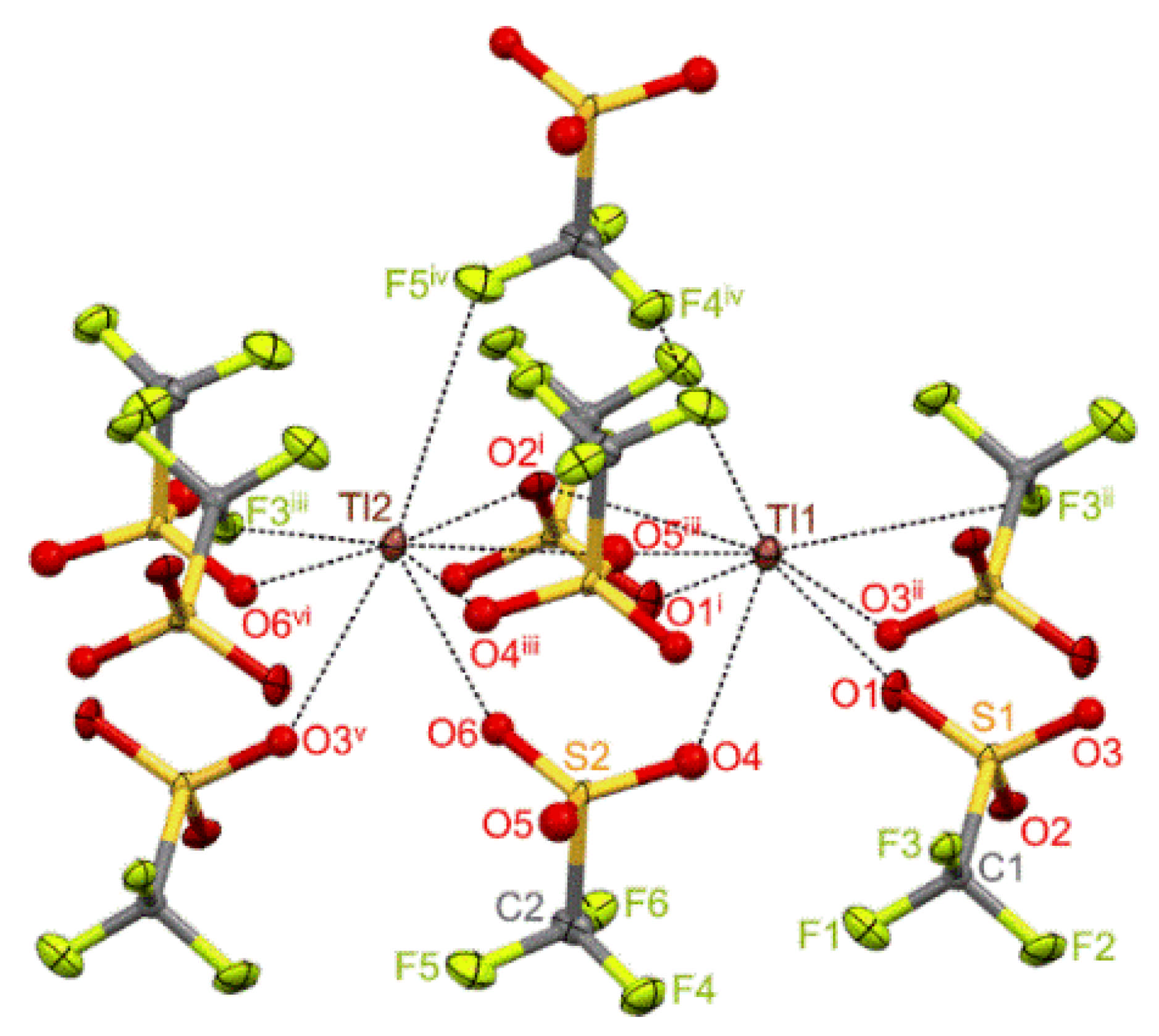
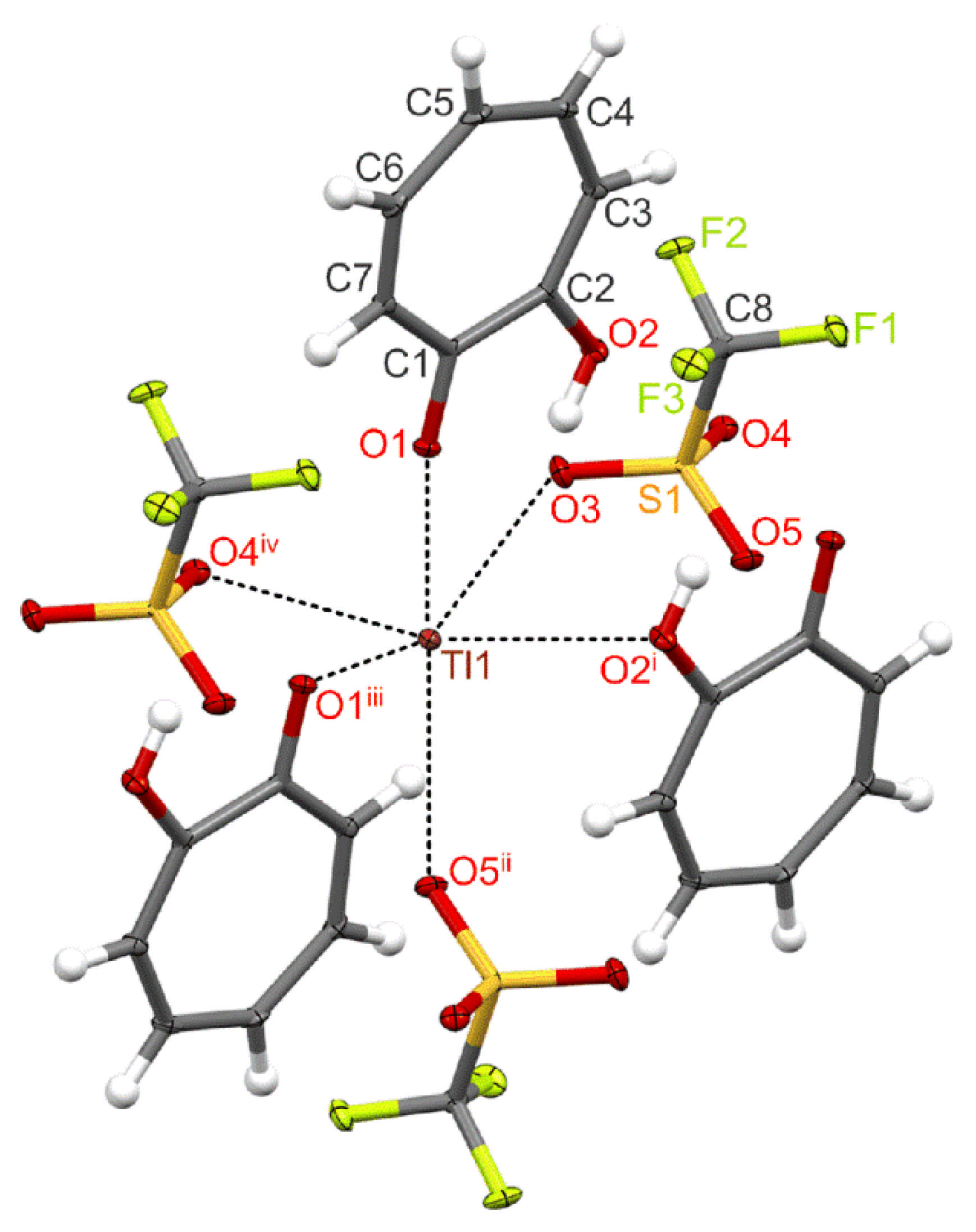
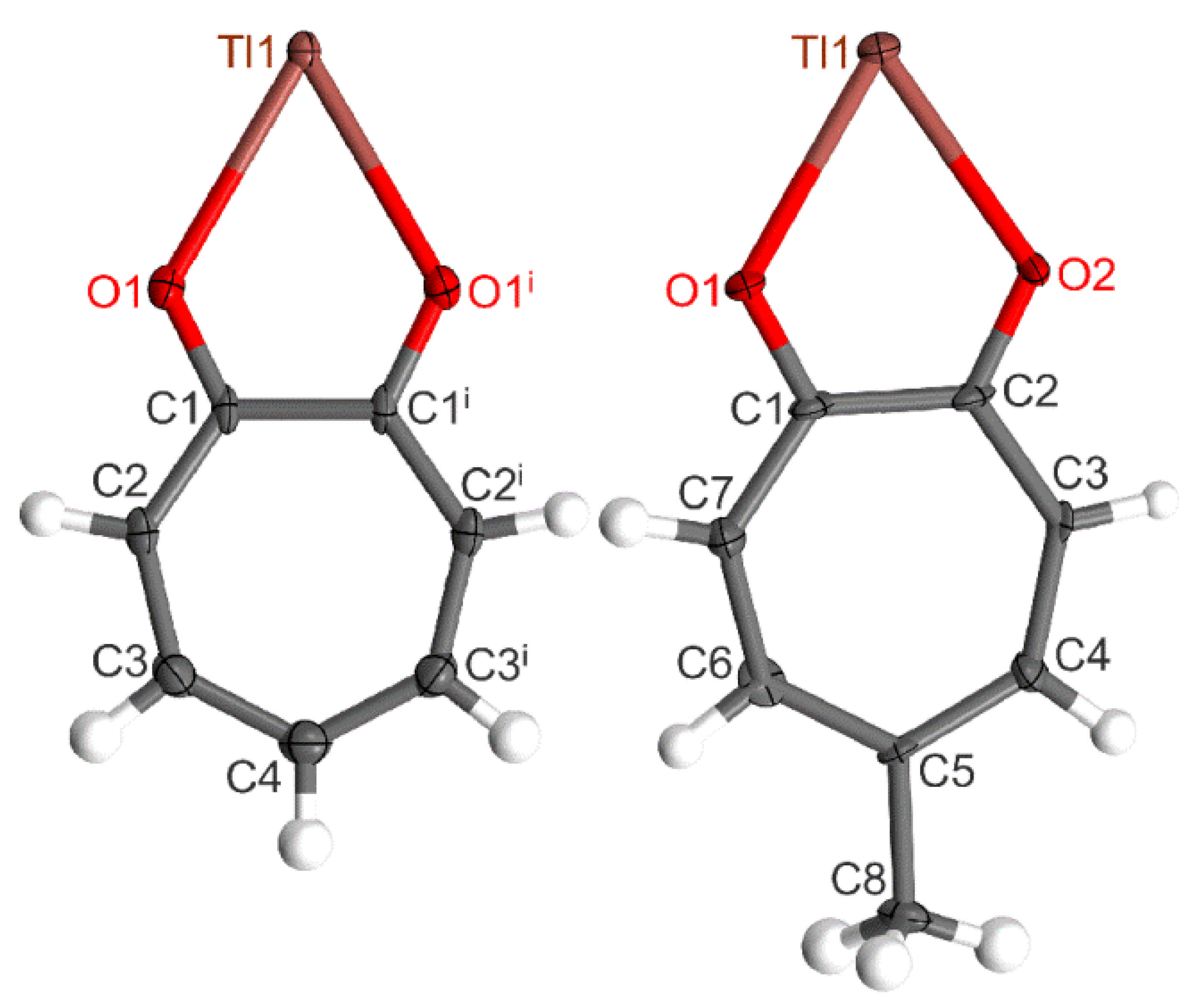
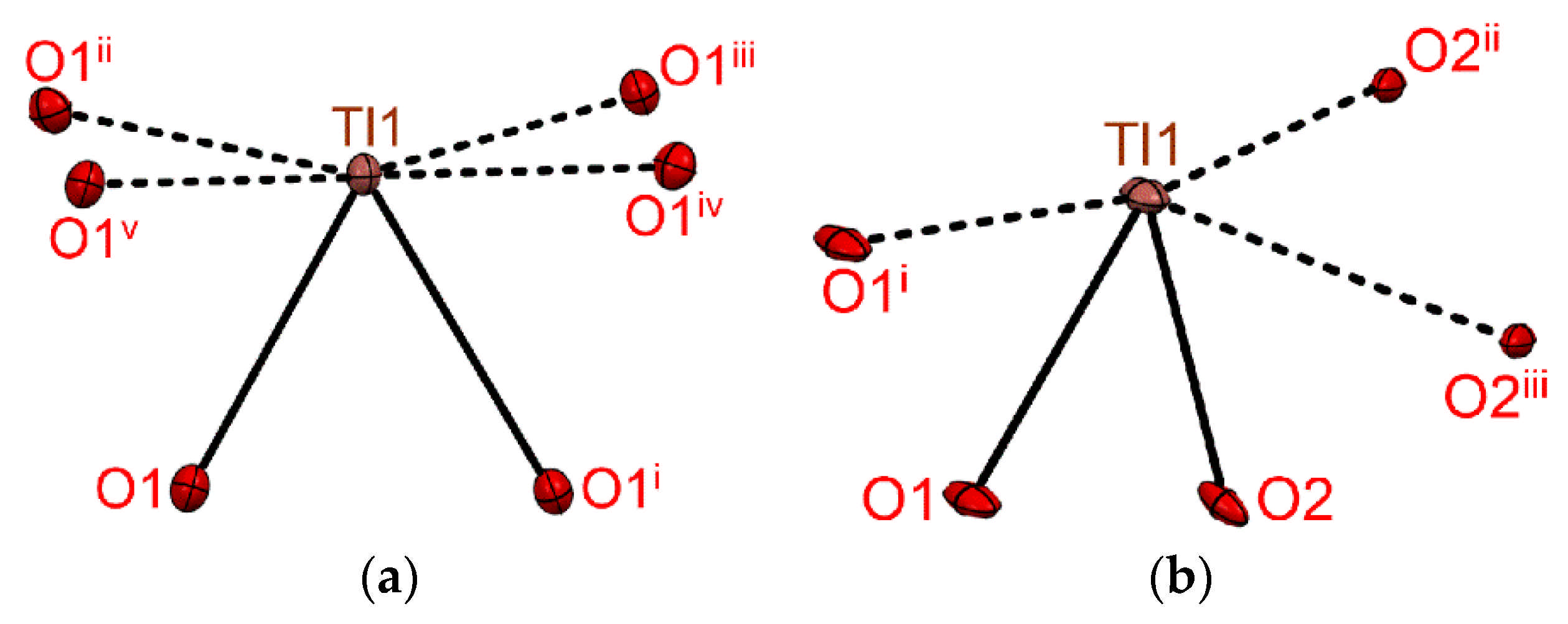

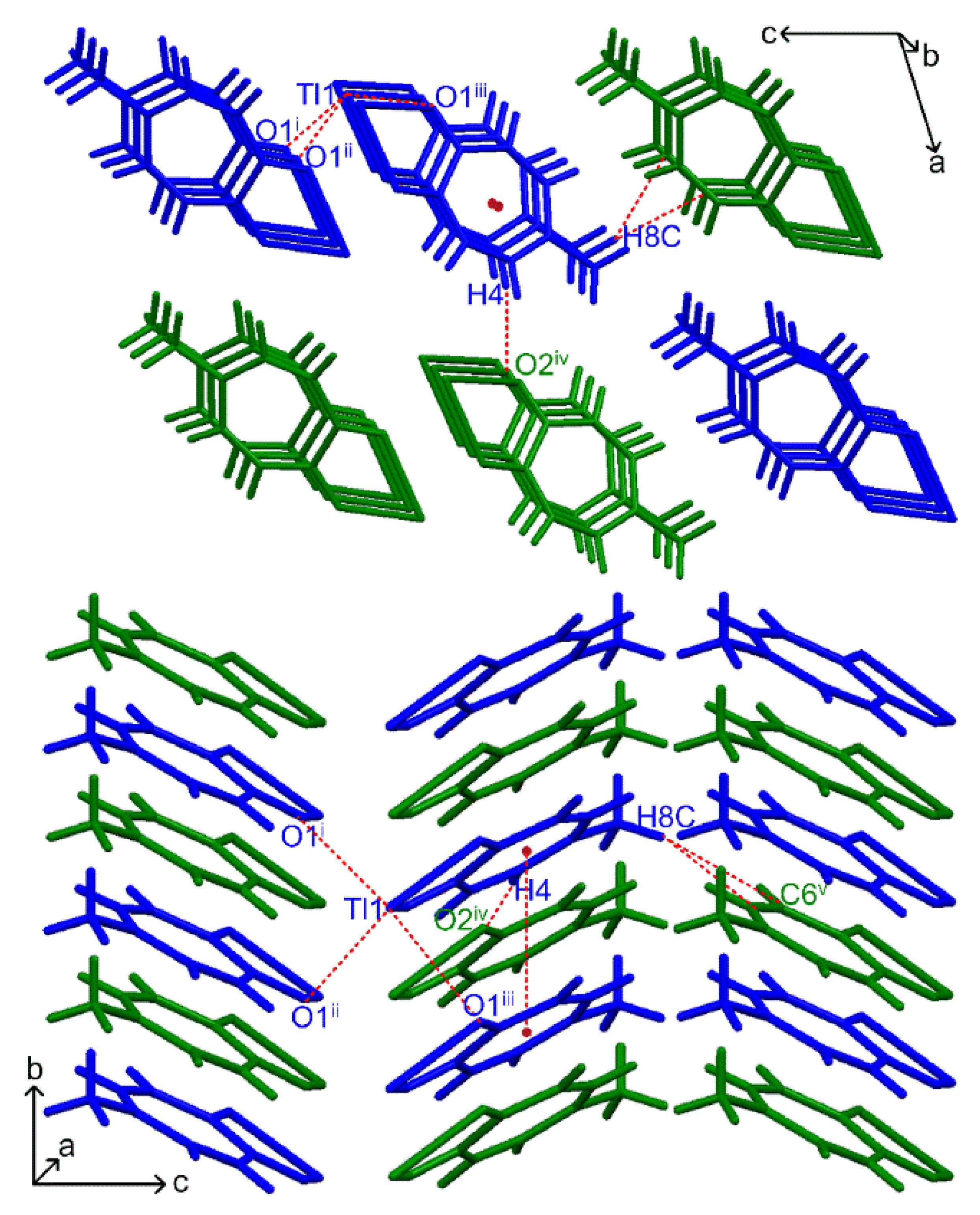
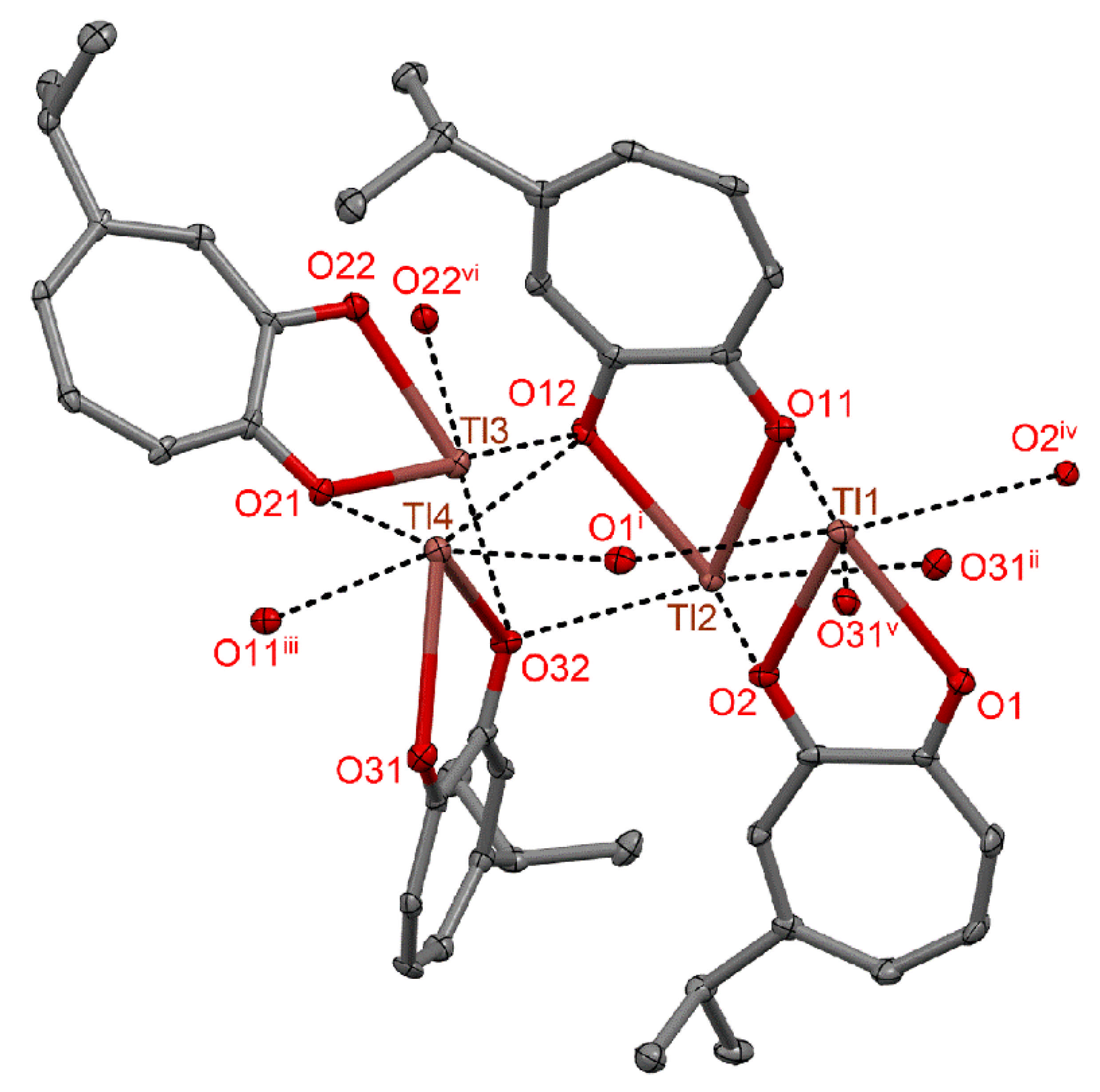
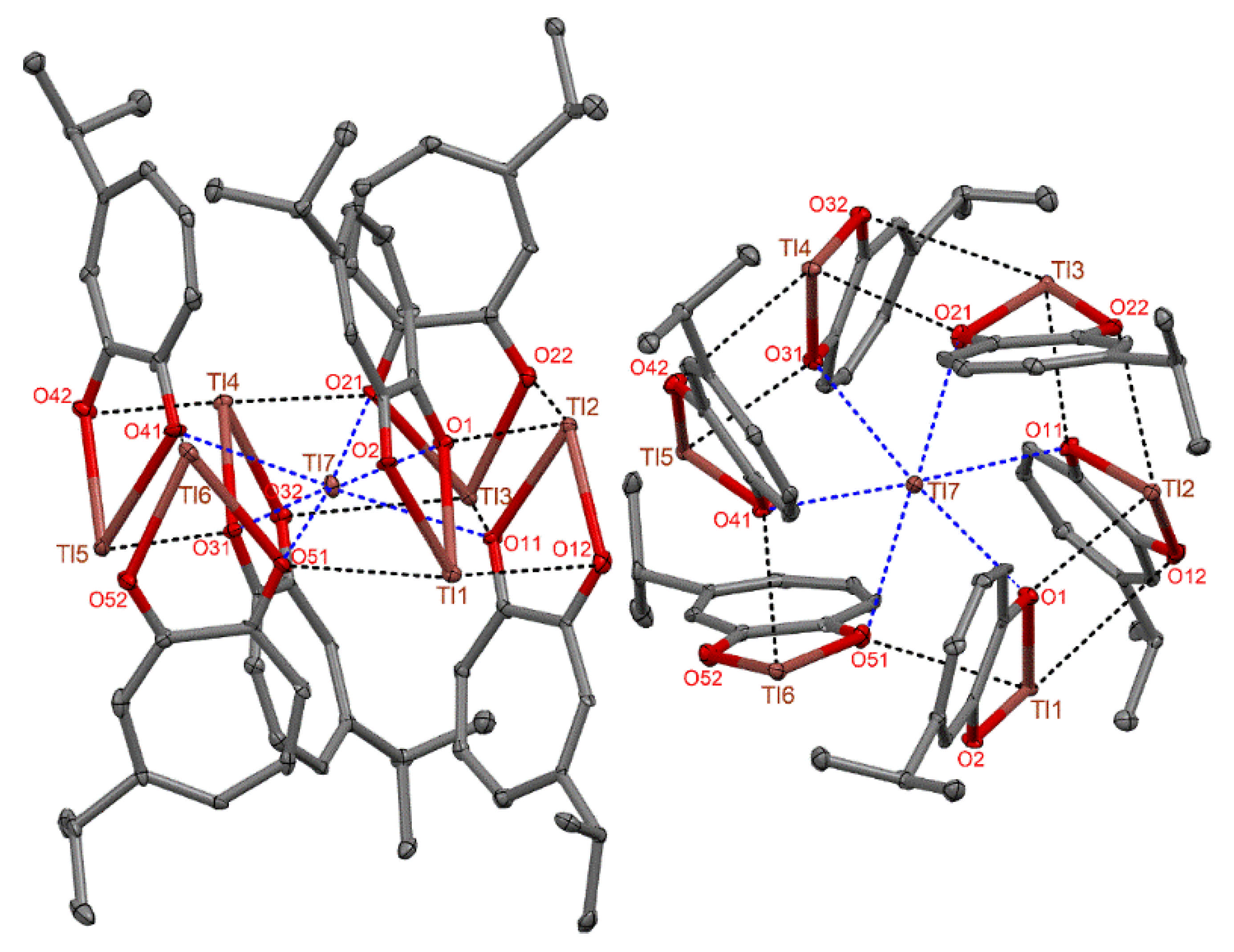
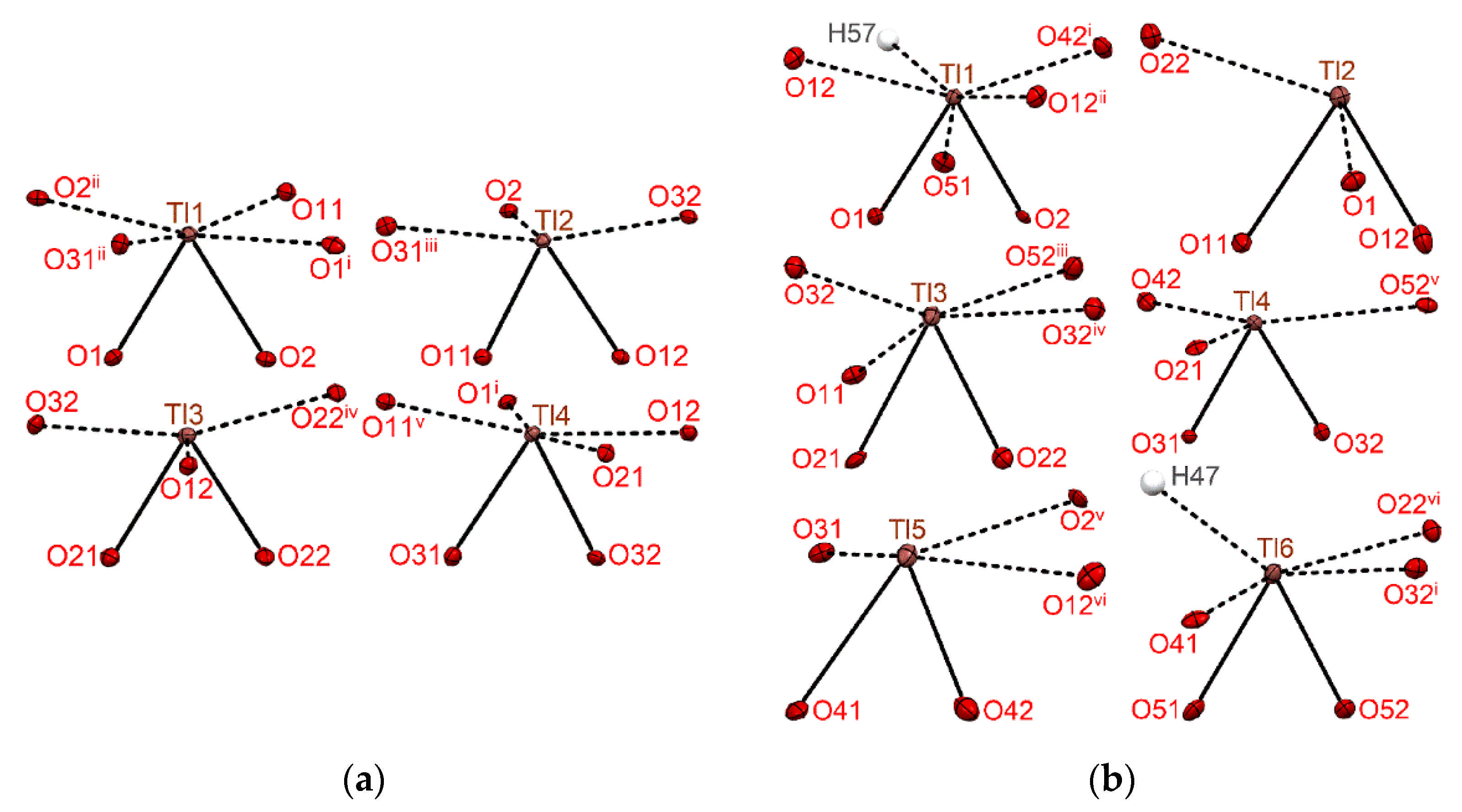


| Tl(OTf) | |||
|---|---|---|---|
| Tl1···O1 | 2.784(18) | Tl2···O6 | 2.782(16) |
| Tl1···O4 | 2.721(14) | Tl2···O2i | 2.798(16) |
| Tl1···O1i | 2.89(2) | Tl2···O4iii | 3.06(2) |
| Tl1···O2i | 3.09(2) | Tl2···O5iii | 2.91(2) |
| Tl1···O3ii | 2.98(2) | Tl2···O3v | 2.85(1) |
| Tl1···O5iii | 2.85(2) | Tl2···O6vi | 2.93(2) |
| Tl1···F3ii | 3.36(1) | Tl2···F3iii | 3.22(1) |
| Tl1···F4iv | 3.43(1) | Tl2···F5iv | 3.35(1) |
| Symmetry codes: (i) −x, −y + 1, −z + 2; (ii) –x − 1, −y + 1, −z + 2; (iii) −x, −y + 1, −z + 1; (iv) x, y + 1, z; (v) x + 1, y, z − 1; (vi) −x + 1, −y + 1, −z + 1 | |||
| Tl(OTf)·Htrop | |||
| Tl1···O1 | 2.722(2) | C1–O1 | 1.271(4) |
| Tl1···O3 | 2.942(2) | C2–O2 | 1.348(4) |
| Tl1···O2i | 3.041(2) | O1–Tl1–O5ii | 135.53(7) |
| Tl1···O5ii | 2.934(2) | O3-Tl1–O1iii | 147.97(7) |
| Tl1···O1iii | 2.744(2) | O2i–Tl1–O4iv | 155.37(6) |
| Tl1···O1iv | 2.871(2) | ||
| (i) −x + 1, −y + 1, −z + 1, (ii) −x + 1, −y + 1, −z + 2, (iii) −x, −y + 1, −z + 1; (iv) x − 1, y, z | |||
| Bond Lengths | Distances | Angles | |||
|---|---|---|---|---|---|
| 1 | |||||
| Tl1–O1 | 2.588(3) | Tl1···O1ii,iv | 2.906(3) | O1–Tl1–O1i | 61.12(13) |
| Tl1–O1i | 2.588(3) | Tl1···O1iii,v | 2.947(3) | ||
| C1–O1 | 1.283(5) | ||||
| Symmetry codes: (i) −x + 1, y, −z + 1.5; (ii) x, −y + 2, z + 0.5; (iii) −x + 1.5, −y + 2, z; (iv) −x + 1, −y + 2, −z + 1; (v) x−0.5, −y + 2, −z + 1.5 | |||||
| 2 | |||||
| Tl1–O2 | 2.446(6) | Tl1···O2i | 2.873(10) | O1–Tl1–O2 | 65.7(3) |
| Tl1–O1 | 2.499(9) | Tl1···O2ii | 2.888(10) | ||
| C2–O2 | 1.284(17) | Tl1···O1iii | 3.189(9) | ||
| C1–O1 | 1.296(14) | ||||
| (i) −x + 0.5, y − 0.5, −z + 1; (ii) −x + 0.5, y + 0.5, −z + 1; (iii) x, y + 1, z | |||||
| Bond Lengths | |||
|---|---|---|---|
| Tl1–O1 | 2.616(3) | C1–O1 | 1.261(5) |
| Tl1–O2 | 2.566(3) | C2–O2 | 1.287(6) |
| Tl2–O11 | 2.538(3) | C11–O11 | 1.266(6) |
| Tl2–O12 | 2.604(3) | C12–O12 | 1.269(5) |
| Tl3–O21 | 2.464(3) | C21–O21 | 1.278(6) |
| Tl3–O22 | 2.487(3) | C22–O22 | 1.266(6) |
| Tl4–O31 | 2.669(4) | C31–O31 | 1.268(6) |
| Tl4–O32 | 2.547(3) | C32–O32 | 1.274(5) |
| Distances | |||
| Tl1···O11 | 2.867(3) | Tl3···O12 | 2.755(3) |
| Tl1···O1i | 2.930(4) | Tl3···O32 | 2.986(3) |
| Tl1···O2ii | 3.011(3) | Tl3···O22iv | 3.322(3) |
| Tl1···O31ii | 3.044(3) | Tl4···O21 | 2.726(3) |
| Tl2···O2 | 2.719(3) | Tl4···O11v | 2.971(3) |
| Tl2···O32 | 2.803(3) | Tl4···O12 | 2.971(3) |
| Tl2···O31iii | 2.989(4) | Tl4···O1i | 3.030(3) |
| Angles | |||
| O1–Tl1–O2 | 61.0(1) | O21–Tl3–O22 | 64.5(1) |
| O11–Tl2–O12 | 61.4(1) | O31–Tl4–O32 | 60.2(1) |
| Bond Lengths | Distances | ||||||
|---|---|---|---|---|---|---|---|
| Tl1–O1 | 2.567(5) | C1–O1 | 1.297(9) | Tl1···O42i | 2.898(6) | Tl5···O31 | 2.712(5) |
| Tl1–O2 | 2.472(5) | C2–O2 | 1.259(8) | Tl1···O12ii | 2.905(6) | Tl5···O12vi | 3.002(6) |
| Tl2–O11 | 2.532(5) | C11–O11 | 1.262(9) | Tl1···O51 | 3.016(6) | Tl5···O2v | 3.017(6) |
| Tl2–O12 | 2.477(6) | C12–O12 | 1.280(9) | Tl1···O12 | 3.446(6) | Tl6···O41 | 2.831(6) |
| Tl3–O21 | 2.652(5) | C21–O21 | 1.303(9) | Tl2···O1 | 2.772(7) | Tl6···O32i | 2.960(6) |
| Tl3–O22 | 2.492(5) | C22–O22 | 1.284(9) | Tl2···O22 | 2.947(6) | Tl6···O22vi | 3.019(6) |
| Tl4–O31 | 2.522(5) | C31–O31 | 1.293(9) | Tl3···O11 | 2.836(6) | Tl7···O41 | 2.868(6) |
| Tl4–O32 | 2.488(5) | C32–O32 | 1.273(8) | Tl3···O52iii | 2.867(6) | Tl7···O1 | 2.878(6) |
| Tl5–O41 | 2.662(5) | C41–O41 | 1.271(9) | Tl3···O32iv | 2.985(6) | Tl7···O51 | 2.897(6) |
| Tl5–O42 | 2.495(6) | C42–O42 | 1.287(9) | Tl3···O32 | 3.430(6) | Tl7···O21 | 2.906(6) |
| Tl6–O51 | 2.621(5) | C51–O51 | 1.265(9) | Tl4···O21 | 2.822(6) | Tl7···O31 | 2.911(6) |
| Tl6–O52 | 2.483(5) | C52–O52 | 1.279(9) | Tl4···O42 | 3.075(6) | Tl7···O11 | 2.979(6) |
| Angles | Tl4···O52v | 3.410(5) | |||||
| O1–Tl1–O2 | 63.9(2) | O31–Tl4–O32 | 63.8(2) | ||||
| O11–Tl2–O12 | 63.1(2) | O41–Tl5–O42 | 61.0(2) | ||||
| O21–Tl3–O22 | 61.7(2) | O51–Tl6–O52 | 62.7(2) |
| Compound | Matrix | λabs max/λem max [nm] | φ [%] | τ [ns] |
|---|---|---|---|---|
| 1 | MeOH | 393/421 | 0.20 a | 0.24 |
| solid | 375,434/411,461 | - | 8.2 (31%), 0.19 (69%) | |
| 2 | MeOH | 402/432 | 0.27 b | 0.22 |
| solid | 375,460/430,502 | - | 12 (57%), 0.15 (43%) | |
| 3 | MeOH | 390/419 | 0.06 b | 0.12 |
| solid | 377,420/417,463 | - | 16 (62%), 0.12 (38%) | |
| 4 | MeOH | 390/421 | 0.06 b | 0.12 |
| solid | 372,426/415,462 | - | 16 (61%), 0.34 (39%) |
| E. coli ATCC 8739 | E. coli ATCC 25922 | S. aureus ATCC 6538 | S. aureus ATCC 29213 | P. aeruginosa ATCC 9027 | P. aeruginosa ATCC 27853 | E. faecalis ATCC 29212 | C. albicans ATCC 10232 | |
|---|---|---|---|---|---|---|---|---|
| Tl(trop) | 256/ND | 128/ND | 256/ND | 512/ND | 256/ND | 128/ND | 512/ND | 128/ND |
| Pb(trop)2 | 128/ND | 64/ND | 128/ND | 128/ND | 512/ND | 256/ND | 64/ND | 64/ND |
| Bi(trop)3 | 16/256 | 8/16 | 16/16 | 8/16 | 32/64 | 16/64 | 8/ND | 512/ND |
| [Bi2(trop)4(NO3)2]n | 16/ND | 16/16 | 16/16 | 8/16 | 32/64 | 32/64 | 16/ND | 128/ND |
| Htrop | 128/ND | 64/ND | 256/ND | 128/ND | 256/ND | 256/ND | 256/256 | 64/512 |
| Tl(5-metrop) | 128/ND | 64/ND | 256/ND | 256/ND | 128/ND | 128/ND | 256/ND | 64/ND |
| Bi(5-metrop)2(NO3) | 16/ND | 8/ND | 8/ND | 8/ND | 8/ND | 16/ND | 2/ND | 32/ND |
| 5-meHtrop | 32/512 | 16/ND | 128/ND | 128/ND | 128/ND | 256/ND | 2/256 | 32/512 |
| Tl(hino) | 128/512 | 128/512 | 128/ND | 64/ND | 256/ND | 256/ND | 64/512 | 32/ND |
| Pb(hino)2 | 64/ND | 64/ND | 128/ND | 256/ND | 512/ND | 512/ND | 64/ND | 64/ND |
| Hhino | 64/256 | 32/128 | 64/256 | 128/ND | 256/ND | 256/ND | 32/ND | 32/512 |
Publisher’s Note: MDPI stays neutral with regard to jurisdictional claims in published maps and institutional affiliations. |
© 2021 by the authors. Licensee MDPI, Basel, Switzerland. This article is an open access article distributed under the terms and conditions of the Creative Commons Attribution (CC BY) license (https://creativecommons.org/licenses/by/4.0/).
Share and Cite
Lyczko, K.; Lyczko, M.; Banasiewicz, M.; Wegrzynska, K.; Ziółko, A.; Baraniak, A.; Dobrowolski, J.C. Thallium(I) Tropolonates: Synthesis, Structure, Spectral Characteristics, and Antimicrobial Activity Compared to Lead(II) and Bismuth(III) Analogues. Molecules 2022, 27, 183. https://doi.org/10.3390/molecules27010183
Lyczko K, Lyczko M, Banasiewicz M, Wegrzynska K, Ziółko A, Baraniak A, Dobrowolski JC. Thallium(I) Tropolonates: Synthesis, Structure, Spectral Characteristics, and Antimicrobial Activity Compared to Lead(II) and Bismuth(III) Analogues. Molecules. 2022; 27(1):183. https://doi.org/10.3390/molecules27010183
Chicago/Turabian StyleLyczko, Krzysztof, Monika Lyczko, Marzena Banasiewicz, Karolina Wegrzynska, Anna Ziółko, Anna Baraniak, and Jan Cz. Dobrowolski. 2022. "Thallium(I) Tropolonates: Synthesis, Structure, Spectral Characteristics, and Antimicrobial Activity Compared to Lead(II) and Bismuth(III) Analogues" Molecules 27, no. 1: 183. https://doi.org/10.3390/molecules27010183
APA StyleLyczko, K., Lyczko, M., Banasiewicz, M., Wegrzynska, K., Ziółko, A., Baraniak, A., & Dobrowolski, J. C. (2022). Thallium(I) Tropolonates: Synthesis, Structure, Spectral Characteristics, and Antimicrobial Activity Compared to Lead(II) and Bismuth(III) Analogues. Molecules, 27(1), 183. https://doi.org/10.3390/molecules27010183









